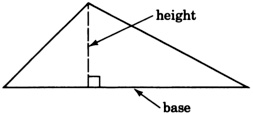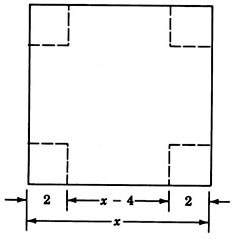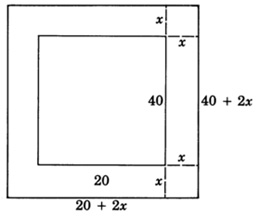10.7: Applications
( \newcommand{\kernel}{\mathrm{null}\,}\)
The Five-Step Method
We are now in a position to study some applications of quadratic equations. Quadratic equations can arise from a variety of physical (applied) and mathematical (logical) problems.
We will, again, apply the five-step method for solving word problems.
- Step 1: Let
- Step 2: Translate the verbal expression to mathematical symbols and form an equation.
- Step 3: Solve this equation.
- Step 4: Check the solution by substituting the result into the equation found in step 2.
- Step 5: Write a conclusion.
Remember, step 1 is very important.
Always start by introducing a variable
Once the quadratic equation is developed (step 2), try to solve it by factoring. If factoring doesn't work, use the quadratic formula. A calculator may help to make some of the calculations a little less tedious.
Sample Set A
A producer of personal computer mouse covers determines that the number
Check these potential solutions.
These solutions check.
Step 5: The computer mouse covers can be priced at either $8 or $27 in order to sell 216 of them.
Practice Set A
A manufacturer of cloth personal computer dust covers notices that the number
Step 1:
Step 2:
Step 3:
Step 4:
Step 5: In order to sell 216 covers, the manufacturer should price them at either or .
- Answer
-
12 or 18
It is estimated that
How many years from now will the population by 95,856?
Step 1:
Step 2:
Step 3:
Step 4:
Step 5:
- Answer
-
In 9 and 15 years, the population of the city will be 95,865.
Sample Set B
The length of a rectangle is 4 inches more than twice its width. The area is 30 square inches. Find the dimensions (length and width).
Step 1: Let

Step 2: The area of a is defined to be the length of the rectangle times the width of the rectangle. Thus,
Step 5: Width
Practice Set B
The length of a rectangle is 3 feet more than twice its width. The area is 14 square feet. Find the dimensions.
- Answer
-
width = 2 feet, length = 7 feet
The area of a triangle is 24 square meters. The base is 2 meters longer than the height. Find the base and height. The formula for the area of a triangle is

- Answer
-
height = 6 meters, base = 8 meters
Sample Set C
The product of two consecutive integers is 156. Find them
This factorization may be hard to guess. We could also have used the quadratic formula.
Step 5: There are two solutions:
Practice Set C
The product of two consecutive integers is 210. Find them.
- Answer
-
14 and 15, and –14 and –15
Four is added to an integer and that sum is tripled. When this result is multiplied by the original integer, the product is −12. Find the integer.
- Answer
-
–2
Sample Set D
A box with no top and a square base is to be made by cutting out 2-inch squares from each corner and folding up the sides of a piece of square cardboard. The volume of the box is to be 8 cubic inches. What size should the piece of cardboard be?

Step 1: Let
Step 2: The volume of a rectangular box is
Step 5: The piece of cardboard should be 6 inches by 6 inches.
Practice Set D
A box with no top and a square base is to be made by cutting 3-inch squares from each corner and folding up the sides of a piece of cardboard. The volume of the box is to be 48 cubic inches. What size should the piece of cardboard be?
- Answer
-
10 in. by 10 in.; 2 by 2 is not physically possible.
Sample Set E
A study of the air quality in a particular city by an environmental group suggests that
a) What is the level, in parts per million, of carbon monoxide in the air now?
Since the equation
b) How many years from now will the level of carbon monoxide be at 8 parts per million?
Step 4: This value of
Step 5: About 3.4 years from now the carbon monoxide level will be
Practice Set E
A study of the air quality in a particular city by an environmental group suggests that t years from now the level of carbon monoxide, in parts per million, in the air will be
a) What is the level, in parts per million, now?
b) How many years from now will the level of carbon monoxide be at 8 parts per million? Round to the nearest tenth.
- Answer
-
(a). 5.1 parts per million
(b). 3.6 years
Sample Set F
A contractor is to pour a concrete walkway around a swimming pool that is 20 feet wide and 40 feet long. The area of the walkway is to be 544 square feet. If the walkway is to be of uniform width, how wide should the contractor make it?
Step 1: Let
Step 2: A diagram will help us to get the equation

(Area of pool and walkway) - (Area of pool) = (area of walkway)
Check a width of 4 feet as a solution.
Area of pool
Area of walkway
This solution checks.
Step 5: The contractor should make the walkway 4 feet wide.
Practice Set F
A contractor is to pour a concrete walkway around a swimming pool that is 15 feet wide and 25 feet long. The area of the walkway is to be 276 square feet. If the walkway is to be of uniform width, how wide should the contractor make it?
- Answer
-
3 ft wide
Exercises
Some of the following problems have actual applications and some are intended only as logic developers. A calculator may be helpful. The problems appear in groups and correspond to the noted Sample Set problem.
Sample Set A—Type Problems
The manufacturer of electronic fuel injectors determines that the number
- Answer
-
$8 or $14
The owner of a stained-glass shop determines that the number
It is estimated that
a) What is the population now?
b) How many years from now will the population be 12,000?
- Answer
-
(a) 12,036
(b) 3 and 12 years from now
It is estimated that
a) What is the population now?
b) How many years from now will the population be 24,000?
If an object is thrown vertically upward, its height
A ball thrown vertically into the air has the equation of motion
a) How high is the ball at
b) How high is the ball at
c) When does the ball hit the ground? (Hind: Determine the appropriate value for
- Answer
-
(a) 48 feet
(b) 64 feet
(c)
A woman's glasses accidentally fall off her face while she is looking out of a window in a tall building. The equation relating
a) How high was the woman’s face when her glasses fell off?
b) How many seconds after the glasses fell did they hit the ground?
Sample Set B—Type Problems
The length of a rectangle is 6 feet more than twice its width. The area is 8 square feet. Find the dimensions.
- Answer
-
length=8; width=1
The length of a rectangle is 18 inches more than three times its width. The area is 81 square inches. Find the dimensions.
The length of a rectangle is two-thirds its width. The area is 14 square meters. Find the dimensions.
- Answer
-
width =
The length of a rectangle is four-ninths its width. The area is 144 square feet. Find the dimensions.
The area of a triangle is 14 square inches. The base is 3 inches longer than the height. Find both the length of the base and height.
- Answer
-
The area of a triangle is 34 square centimeters. The base is 1 cm longer than twice the height. Find both the length of the base and the height
Sample Set C—Type Problems
The product of two consecutive integers is 72. Find them.
- Answer
-
−9,−8 or 8,9
The product of two consecutive negative integers is 42. Find them.
The product of two consecutive odd integers is 143. Find them. (Hint: The quadratic equation is factorable, but the quadratic formula may be quicker.)
- Answer
-
−13,−11 or 11,13
The product of two consecutive even integers is 168. Find them.
Three is added to an integer and that sum is doubled. When this result is multiplied by the original integer the product is 20. Find the integer.
- Answer
-
Four is added to three times an integer. When this sum and the original integer are multiplied, the product is −1. Find the integer.
Sample Set D—Type Problems
A box with no top and a square base is to be made by cutting out 2-inch squares from each corner and folding up the sides of a piece of cardboard. The volume of the box is to be 25 cubic inches. What size should the piece of cardboard be?
- Answer
-
A box with no top and a square base is to made by cutting out 8-inch squares from each corner and folding up the sides of a piece of cardboard. The volume of the box is to be 124 cubic inches. What size should the piece of cardboard be?
Sample Set E—Type Problems
A study of the air quality in a particular city by an environmental group suggests that
a) What is the level, in parts per million, of carbon monoxide in the air now?
b) How many years from now will the level of carbon monoxide be at 3 parts per million?
- Answer
-
(a) carbon monoxide now 2.2 parts per million
(b) 2.37 years
A similar study to that of problem 21 suggests
a) What is the level, in parts per million, of carbon monoxide in the air now?
b) How many years from now will the level of carbon monoxide be at 3 parts per million?
Sample Set F—Type Problems
A contractor is to pour a concrete walkway around a wading pool that is 4 feet wide and 8 feet long. The area of the walkway and pool is to be 96 square feet. If the walkway is to be of uniform width, how wide should it be?
- Answer
-
Astrophysical Problem
A very interesting application of quadratic equations is determining the length of a solar eclipse (the moon passing between the earth and sun). The length of a solar eclipse is found by solving the quadratic equation
for
The following constants are from a solar eclipse that occurred on August 3, 431 B.C.
Determine the length of this particular solar eclipse.
Exercises For Review
Find the sum:
- Answer
-
Solve the fractional equation
(Hint: Check for extraneous solutions)
One pipe can fill a tank in 120 seconds and another pipe can fill the same tank in 90 seconds. How long will it take both pipes working together to fill the tank?
- Answer
-
Use the quadratic formula to solve
Use the quadratic formula to solve
- Answer
-


